Agricultural industry
Ukraine has significant potential in the agricultural processing industry due to its rich raw material base, vast agricultural land, favorable climatic conditions, and advantageous location near key consumer markets.
Ukraine consistently ranks among the world leaders in agricultural production and exports. The main crops include wheat, corn, barley, sunflower, sugar beets, legumes, vegetables, and fruits. The country ranks 4th globally in grain exports, supplying 7.8% of the world’s wheat exports. Ukraine is the leading global exporter of sunflower oil, third in rapeseed and oilcake exports, and fourth in corn exports. The annual harvest reaches approximately 70 million tonnes, fully covering domestic demand and exports. In 2024, the trade turnover of agricultural and food products amounted to 32.2 billion USD, of which 24.6 billion USD were exports. The total net weight of exported products reached 78.3 million tonnes.
The agricultural sector’s share of added value in 2024 was 8.2% of GDP. Additionally, the sector contributed around 22.3 billion UAH in tax revenues, which is about 2% of the national total.

Ukraine also plays an important role in ensuring global food security, especially in the context of the current crisis. The country’s export potential is sufficient to feed up to 0.6 billion people worldwide.
Agricultural processing in Ukraine has vast potential, as the country mostly exports raw products. Developing deep processing such as producing oil, flour, meat and dairy products, canned goods, juices, and semi-finished foods would significantly increase added value, strengthen export capabilities, and create new jobs.

The agro-processing sector is a key and growing part of the national economy, offering strong opportunities for investors. As of 2024, the stock of foreign direct investment (FDI) in the agricultural sector amounted to 3.3 billion USD, accounting for 6% of all FDI in Ukraine. The largest shares were directed toward growing annual and biennial crops, livestock farming, post-harvest processing, and support activities in agriculture.
Impact of the war
The war has caused enormous damage to the agricultural sector, with losses estimated in the billions of dollars. Key contributing factors include military actions that destroyed crops, limited access to agricultural resources, and workforce migration. Total direct losses to Ukraine’s agro-industrial sector and land resources are estimated at 10.3 billion USD, or 6% of the country’s overall war-related damage. Recovery and reconstruction needs for the agricultural sector are estimated at 55.5 billion USD.
The blockade of Black Sea ports created major obstacles to grain exports. Ukrainian farmers faced challenges delivering products to global markets, which led to declining revenues and growing volumes of unsold grain. Infrastructure such as grain elevators, warehouses, and transportation routes was heavily damaged or destroyed.

Despite these challenges, the agricultural sector has shown strong adaptability. The implementation of modern technologies in agriculture has helped improve production efficiency, allowing Ukrainian farmers to regain lost ground and achieve sustainable growth. With further investments in farming methods, education, irrigation, logistics, and high value-added production, Ukraine has all the prerequisites to restore and even double its pre-war food export volumes.
Under the Law of Ukraine No. 1116 “On State Support for Investment Projects with Significant Investments in Ukraine” processing industry has been designated a priority industry and is eligible for state support of up to 30% of CAPEX.
Although Ukraine has long been among the global leaders in agricultural production and exports thanks to its highly fertile soil, attractive land lease prices, competitive labor costs, logistics advantages, and the resilience of its farmers there is still considerable potential to boost productivity further.









